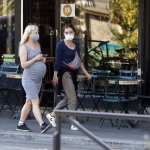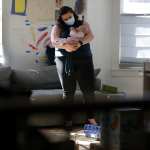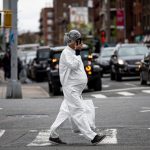We’re the only newsroom dedicated to writing about gender, politics and policy. Subscribe to our newsletter today.
Pregnant people are more likely to die if they contract COVID-19, according to a new report published by the Centers for Disease Control and Prevention.
The report, put out Monday, is a major development from a previous study. In June, the CDC found that pregnancy was linked to higher risk of medical complications, including intubation, but it had not yet linked pregnancy to COVID-19 mortality. The June study countered months’ worth of CDC advice that pregnant people were not at any heightened risk.
Even before the pandemic, the United States’ death rate for pregnant and postpartum people was among the worst of other wealthy nations — 17.4 maternal deaths per 100,000 live births in 2018, according to data from the CDC. Pregnancy-related mortality rates were substantially higher for Black people.
“It is really important to focus on the additional risk that COVID provides on top of an already unexpectedly high rate of maternal mortality in this country,” said Katy Kozhimannil, an associate professor at the University of Minnesota and director of its rural health research center.
Already, concerns about how COVID might affect pregnant people had been linked to heightened anxiety and other mental health concerns. About a third of people who could become pregnant have chosen to delay or rethink how many children they would like to have because of the pandemic, according to the Guttmacher Institute.
It’s unclear whether the new findings would add to those mental health burdens, said Dr. Cindy Liu, an assistant professor at Harvard Medical School who has studied mental health and pregnancy during the pandemic.
“They’re reporting COVID is [already] having an effect on how they think about their pregnancy,” she said. “I don’t know if it’s going to make them even more nervous, because they’re already concerned about giving birth.”
The CDC report comes from an analysis of 400,000 women — both pregnant and not pregnant — between the ages of 15 and 44. (The CDC study did not account for pregnant people who are not women.) Of those women, 23,434 were both pregnant and symptomatic for COVID.
Pregnant women with symptomatic COVID-19 were significantly more likely to be admitted to the intensive care unit, to require a ventilator and to die of the virus; 1.5 per 1,000 symptomatic pregnant women died of COVID, compared to 1.2 per 1,000 non-pregnant women. Those between ages 35 and 44 were more likely to die than those younger than 24. Pregnant women of Asian and Pacific Islander descent were more likely to require intensive care, compared to their non-pregnant counterparts.
And, pregnant or not, Black women constituted a disproportionate share of women who died — making up 36.6 percent of deaths overall, even though just 14.1 percent of women in the study were Black. That disparity mirrors the virus’ overall impact: Black and Latinx people have been hit harder by the pandemic.
The data underscores the importance of probing disparities in both pregnancy-related health and COVID deaths, Kozhimannil said. Race is one such factor; whether someone lives in a rural or urban area is another, especially since pregnancy-related care is often harder to come by further away from cities.
“if we look only at one slice of the crisis … we’re missing other elements,” she said. “COVID is shining a light on a lot of the underlying problems we have.”
The study authors say that, because of the findings, pregnant people should limit the possibility of exposure to COVID-19, avoiding people both within their households and in the outside world who may have been infected.
But that may be easier in theory than in practice. Almost half of all pregnancies in the United States are unintended. And pregnant people who work in schools that have reopened, or in health care settings — both professional settings that employ more women than men — aren’t necessarily able to stay home. Many frontline workers aren’t guaranteed paid maternity leave.
“These are people who are deciding between keeping their job at the grocery store or Walmart or as a nurse or X-ray technician, and they may need that job to be able to keep their health insurance in pregnancy, or to be able to afford to provide childcare for the baby when it’s born,” Kozhimmanil said. “It’s just an untenable choice for many folks.”






